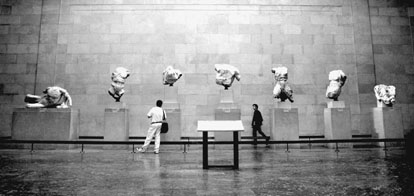

 | Page 467 |  |

Tourists view the famous Elgin Marbles on display at the British Museum in London.
(Reuters NewMedia Inc./Corbis)
In this diplomatic position Elgin took the opportunity to more closely study and record the extant ancient Greek monuments and art within Greater turkey, which included what is now greece. Elgin was influenced and inspired by the great collector sir william hamilton, who had been impressing London with his Roman antiquities from pompeii. At his own expense Elgin employed the painter Lusieri and several skilled draftsmen and modelers, who were sent to Athens to begin to record its monuments. In 1801 Elgin received permission from the Turkish administration to build a scaffolding around what they called the “temple of Idols” or the Parthenon in Athens, in order to make molded copies of the sculptures and reliefs around its pediments. During this process the ongoing damage to the building and its detail by the Turks, as well as the French ambassador’s interest in them, convinced Elgin that it would be safer to remove some of the Parthenon sculptures and other monuments from Athens in order to preserve them. As a result of this Elgin has been described as just another aristocratic antiquarian collector intent on pillaging the monuments of the Mediterranean—even for the best of reasons—for proof of his erudition, for the education of the upper